Night Pistol Fighting

 There are 3 things you need to do with threats in the dark:
There are 3 things you need to do with threats in the dark:
1) Locate potential threats
2) Identify whether or not something IS a threat
3) If so, you need to hit it.
Many of us get “night” sights on our pistols, because we know that the majority of armed encounters occur in low light. But luminous sights, “red dot” reticles (which may or may not be red, or dots), lasers, and other night sighting tools only help us hit a target, not find it or identify it–and then, only if we’ve trained with them in reduced light.
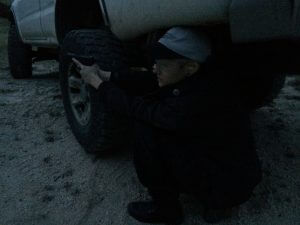
 IFF
IFF
The most difficult of the above requirements is 2), what the military calls IFF (identifying, friend or foe). It’s the second O of your OODA cycle. Our Night Fighting classes will help you get better at all three. Plus, there are few things in life more fun than seeing that muzzle flash silhouette your sights!
INTEGRATING THE HAND-HELD FLASHLIGHT WITH A PISTOL, SHOTGUN, PDW, OR CARBINE
Some schools (if they offer low light training at all) teach you only one flashlight “technique.” They say “There are others, but this is the best, so master it.” Others introduce the students to a few different methods, and tell the students to choose the one that works best for them. Either way, they usually teach these methods static (feet planted on a firing line). At best, they do “light on, light off, sidestep 1 or 2 steps.”
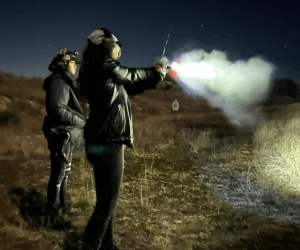
Some feel that if they have a weapon mounted light, they need not learn hand-held techniques. Weapon mounted lights are great. But with a hand-held, you can “lead with the light” around corners, even running a carbine. As Tiger McKee pointed out, different methods work better in different situations, so you should be able to “flow” seamlessly from one to the other. We will put you in various scenarios, so you’ll have a context of when to use each.
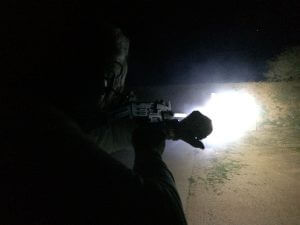
MOVEMENT
Early on, we’ll introduce movement. Picture this: you and your honey have been out for a night on the town. There is a civil disturbance or active shooter situation not too far away. You’re just trying to get away from there. As you two move, you use your flashlight to identify potential threats, in this order of precedence:
1) Unidentified people
2) Open doors, alleyways, and other thresholds
3) Closed doors
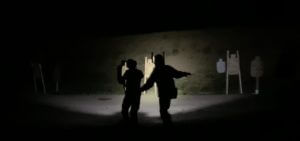
If you are right handed, a Weaver or C.A.R. based hold (such as Harries) will work better to scan alleys to your left as you pass them. But a one-handed Neck Indexed would work better for open alleys to your right. When you’re not sure if there’s someone crouching behind that car bumper, an extended FBI hold might help you cast shadows around it to see if there’s someone there, before you commit your whole body to that corner.
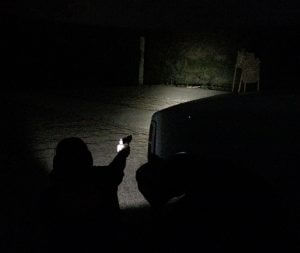
CLOSE CONTACT
Of, course, we’ll start with “flash and smash” techniques for repelling boarders in case you get jumped before you get a chance to unlimber your firearm. You’ll learn ways to “compress” Harries, Neck Indexed, Chapman, Rogers-Surefire, and other flashlight holds. We’ll also cover when–and when NOT–to use weapon mounted lights (remember, it’s a gun with a light attached, not a flashlight with a gun attached).
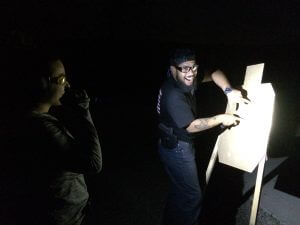
ESCAPE AND EVASION
During E&E situations, you’ll want to have a flashlight (or three) available, but you’ll want to use it sparingly, if at all. We’ll teach you silhouetting methods for clearing a culvert or underpass in the dark, without lighting up. If you have a partner covering your “six” as you move through unknown threat ares, we’ll teach them to coordinate their light use with yours, so you minimized back-lighting each other.
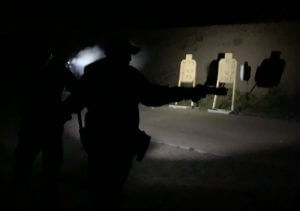
DECISION SHOOTING
Because we have less SA (situational awareness) in the dark, our Night Fighting classes are ideal for practicing Decision Shooting: identifying which of those blobs is the threat or threats, and only engaging them. We feel that some sort of target discrimination training should be mandatory before you can receive certification to carry concealed (a CCW permit). It’s no longer a legal requirement in Arizona, but Heloderm CCW certification classes still require it.
Fighting well demands judgment based on quality training and experience, as well as mastery of several complex motor skills. In reduced light, complexity increases. Picture yourself in that movie theater in Aurora Colorado. Would you be able to find, identify, and eliminate the killer in that confused, chaotic, and smoke-filled environment, while the Batman movie on the screen is destroying your night vision?
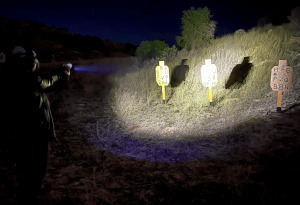
If you’re interested, we’ll play with laser target designators, thermal imagers, or other night vision technology.
We will also have an optional HTE (human target engagement) exercise. You will be screened for live weapons, and use Airsoft or marking cartridges to do a night fighting scenario against a real person armed with blanks.
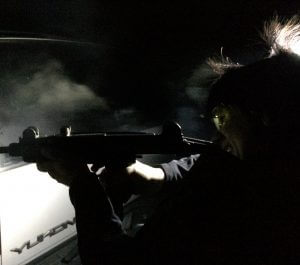
As the complexity of your shooting problems increases, so does the need for risk management. We keep these classes small so each student gets more attention, and to mitigate the risks inherent in this type of training.
Contact us to request low light training, or if you just want to know more.
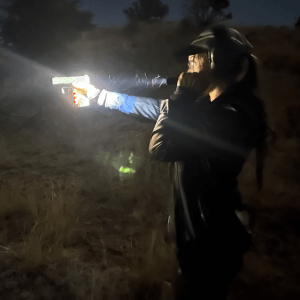

 IFF
IFF